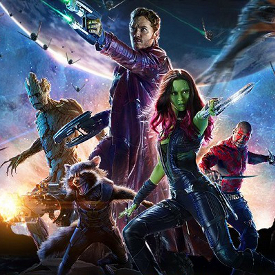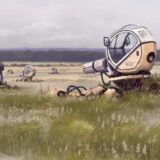
Last week, in my 390th column for Amazing Stories® Online, I said a few words about Canadian science fiction (and here I include fantasy) writers, and how I’d not known growing up that any SF/F writers were Canadian. Well, after living here in Canada for thirty-eight years, I’m happy to say that my ignorance has lessened; I might even know more living Canadian SF/F writers than American ones! And I’m proud and happy to say that one of the greatest (I hate to hyperbolize, but this guy’s continually reaching new heights) living Canadian SF writers, Robert J. Sawyer (Figure 2), is a friend, and this friend has come out—TODAY!—with a new book that’s sure to be an award winner!

Figure 1 shows the cover of Rob’s new book, The Downloaded, of which today is the official launch day, as well as the launch date for Rob’s May cross-Canada book tour, beginning in Calgary, AB and continuing to five other cities. And later in the year he’ll be hitting ten other cities—not including Vancouver, darn it. (You can find details of the tour on Rob’s personal website, linked here: https://sfwriter.com/.
Although the book has been available as an audio book from Audible for a while, I have a hard time listening to audiobooks myself, as I have to concentrate on the book and can’t multitask while listening. (Of course, as with all my stuff, Your Mileage May Vary; you might find that easy to do.) But here I’m going to review my advance eBook copy of The Downloaded for you; I will attempt to keep spoilers to a minimum.
In The Downloaded (Figure 1), Rob tackles a number of ideas, completely blowing up the old idea that a story or book should concentrate on one idea at a time, lest it confuse the story and the reader. In this book, Rob talks about cryogenic preservation of body with electronic preservation of mind; he talks about intelligent robots and their desires; he brings in possible (and plausible) world catastrophes, and what might happen with and to humans who inhabit the planet Mars over a couple of centuries. All this idea stuff is filtered through a set of believable and well-rounded characters.
The idea of cryogenics, freezing and then reviving humans, has been around for a while both in real life and in fiction; a number of people—including some famous ones (rumour has it that Walt Disney is one)—have been frozen in the hopes that future people will be able to revive them and fix whatever’s wrong with them.
It’s been around so long it’s become a trope—Heinlein’s Door Into Summer depends on cryogenics (as well as time travel) for the story to even work. There are other examples, but so far, nobody’s been able to revive any large multi-cellular animals successfully that I know of. But Sawyer plausibly tells us why: consciousness is an emergent property of life involving quantum mechanics; when a body is frozen it is for all purposes dead, so the mind/consciousness departs. But if you are able to create a virtual world in a powerful-enough computer, the mind/consciousness can be transferred into it—uploaded—without a loss. Then, in the future, downloaded to that thawed body, thus keeping the mind/body link.
So putting that together with the idea of a very long voyage to a nearby star (let’s say Proxima Centauri B), they figure that if it takes a couple of hundred years in real time, the brain could be uploaded into a computer and live whatever life it wanted, while the body stayed young, frozen and healthy. So theycrammed a bunch of astronauts into cryotubes and got ready to launch ‘em. Only when the astronauts awoke from their virtual worlds (worlds tailored to cater to their every whim), ready to be downloaded into their bodies, there were a couple of hitches: one, that the bodies hadn’t been put on the ship; and two, that neither the ship nor their bodies had actually made the trip. And that although it was, in fact, five hundred years after they got frozen, neither they nor the ship had gone anywhere. Something had happened soon after they had bee frozen.
Furthermore, the putative colonists weren’t alone upon wakening—a pilot project involving some frozen convicts had also been underway at the same time, and everyone was waking up in a future world that was nothing like the world they had left.
The world had undergone what they figured was a major solar flare, and only the project—based at the Quantum Cryonics Centre of Waterloo, Ontario—thanks to its solar power and a few intelligent robot tenders—had survived. The rest of humanity, except for a small community of Amish farmers (who were not only not dependent on electronics, but thrived despite the lack of electronics) was gone. And now everyone who had been frozen was dumped back into a horrible present.
One of the things Sawyer is able to do is to face a calamity or catastrophe with human characters who are able to reach within themselves and come to terms with what’s happened, then move ahead (as in Flash Forward, an earlier book that was turned into a TV series). His characters in this book include dedicated astronauts, as well as reluctant ones, convicted criminals who are unprepared for the world they find after they’ve served what was supposed to be a short physical, but long mental term; intelligent robots who are questioning the idea of, and rationale for, Asimov’s “Three Laws of Robotics”; Amish farmers who, having lived therough the decline of “modern civilization” are planning to continue to rebuild the world on saner, more peaceful lines, and Martians, who are also questioning whether mankind on good ol’ Planet Earth really has any relevance to Mars or indeed, whether they were even human—so would humanity have any relevance to them? All these questions are being asked while a plot rolls along so smartly that you don’t even realize there are serious ideas being posited here.
I found the book well written and quite involving; and I couldn’t help thinking about the protagonists and their various dilemmas—as well as Sawyers’ proposed soluions. I’ve now read the book three times, and I suspect you’ll be reading it more than once yourself.
The Downloaded is available from Audible as an audiobook, and from Amazon (.com, .ca, etc.) as a Kindle book in the US, Canada, the U.K., and Australia. It’s available from kobo.com as a Kobo book; and it’s available from Barnes and Noble and other ebook sellers worldwide. If you want a print copy, you can get one from Amazon and Barnes & Noble at the same branches shown above; it’s available from Bakka Books in Canada as well as other booksellers (The Downloaded by Robert J. Sawyer; the ISBN is 978-1-989398-99-9) or an autographed copy from Rob at the link above.
Comments? Questions? Suggestions? You can comment here, or on Facebook, or even by email (stevefah at hotmail dot com). I welcome all comments as long as you’re polite about it. My opinion is, as always, my own, and doesn’t necessarily reflect the views of Amazing Stories or its owner, editor, publisher or other columnists. See you next time!










